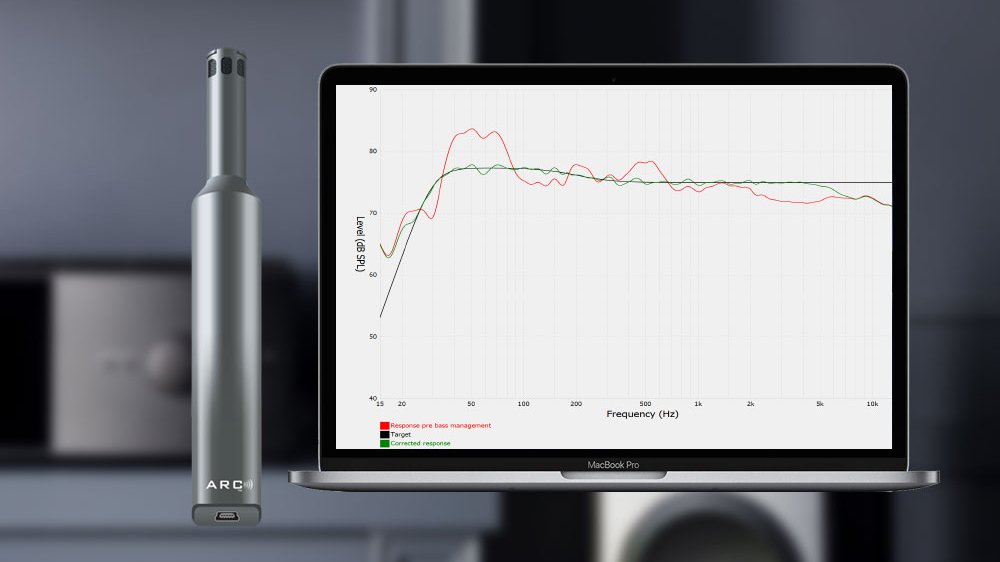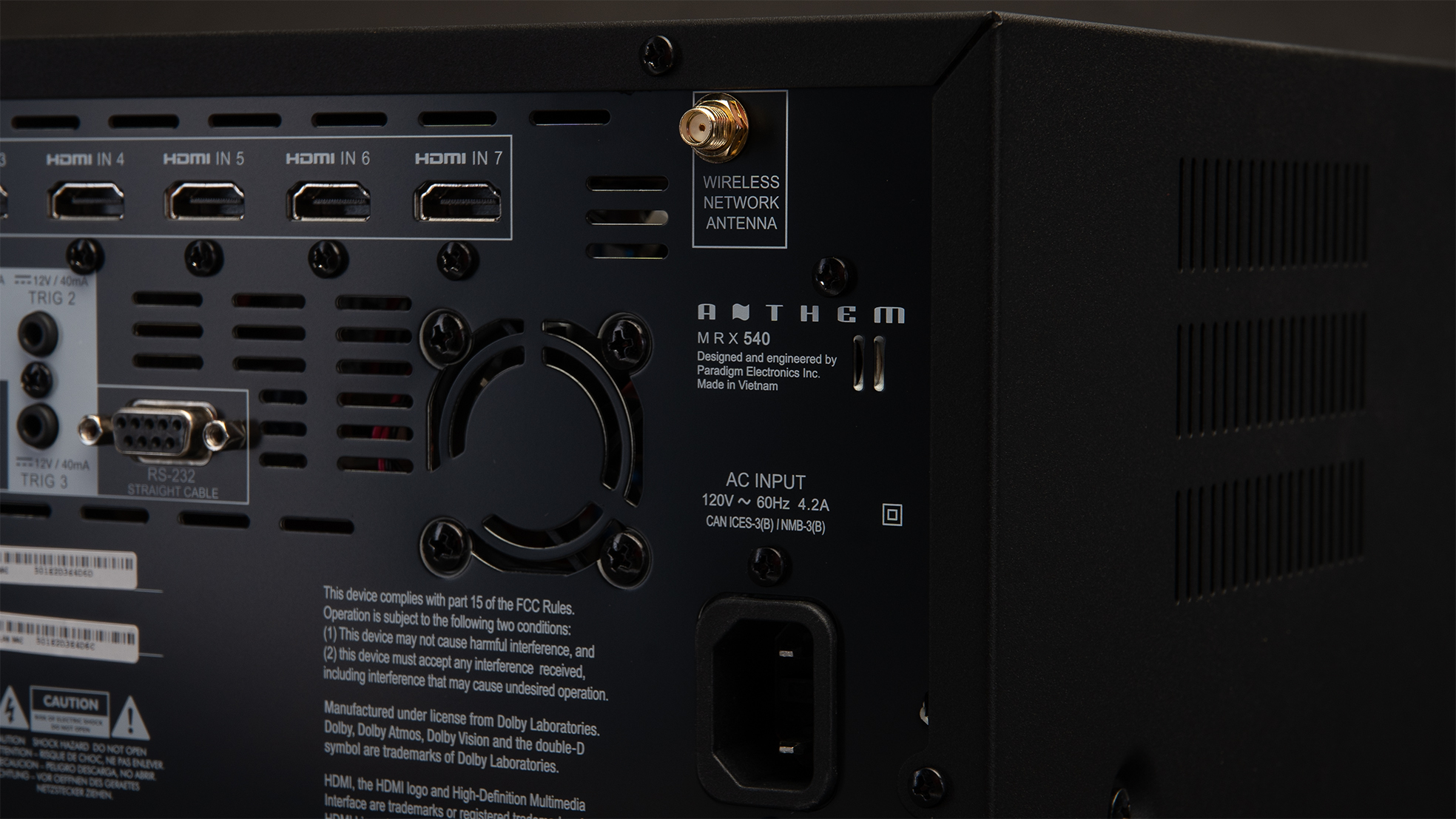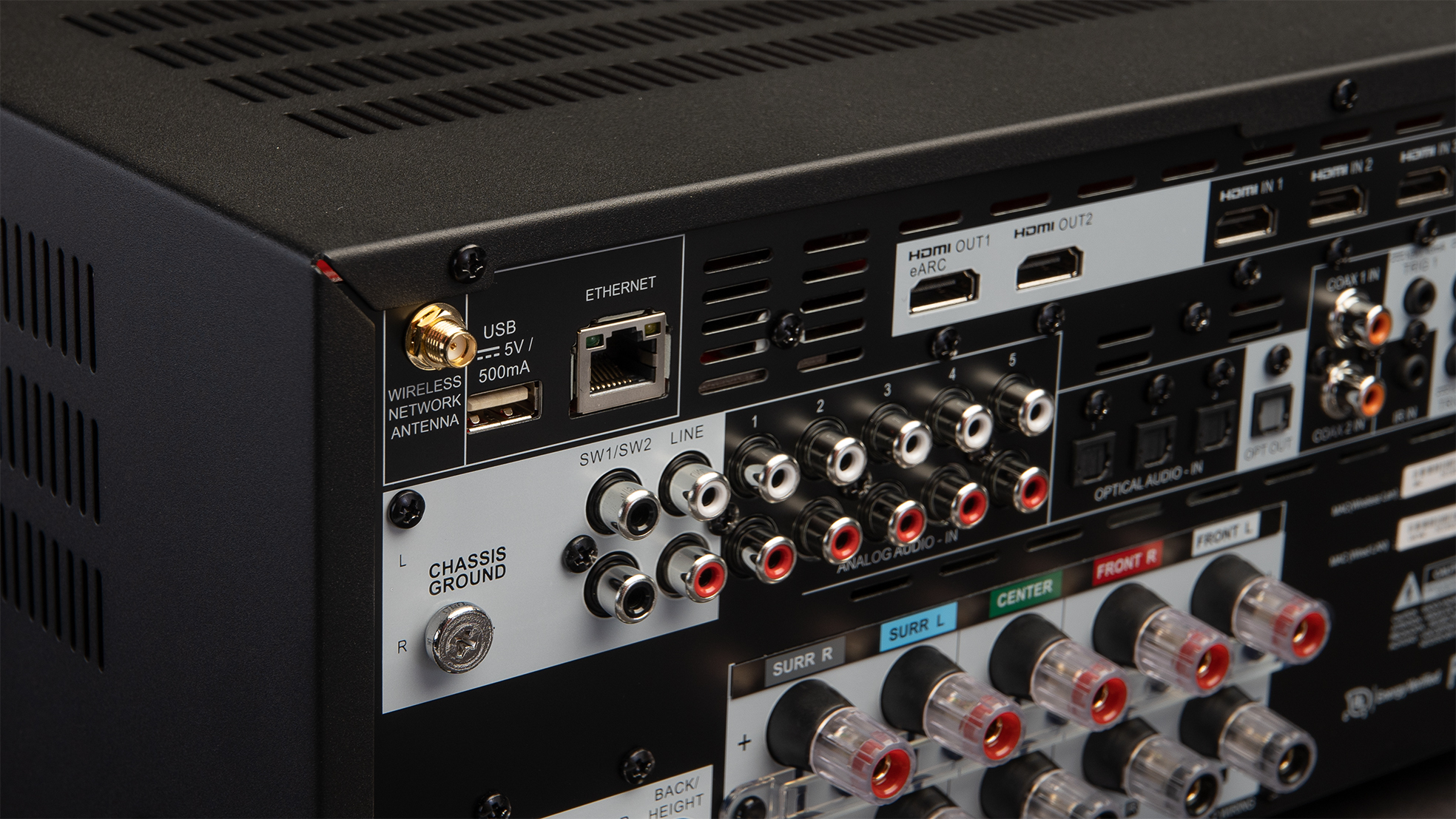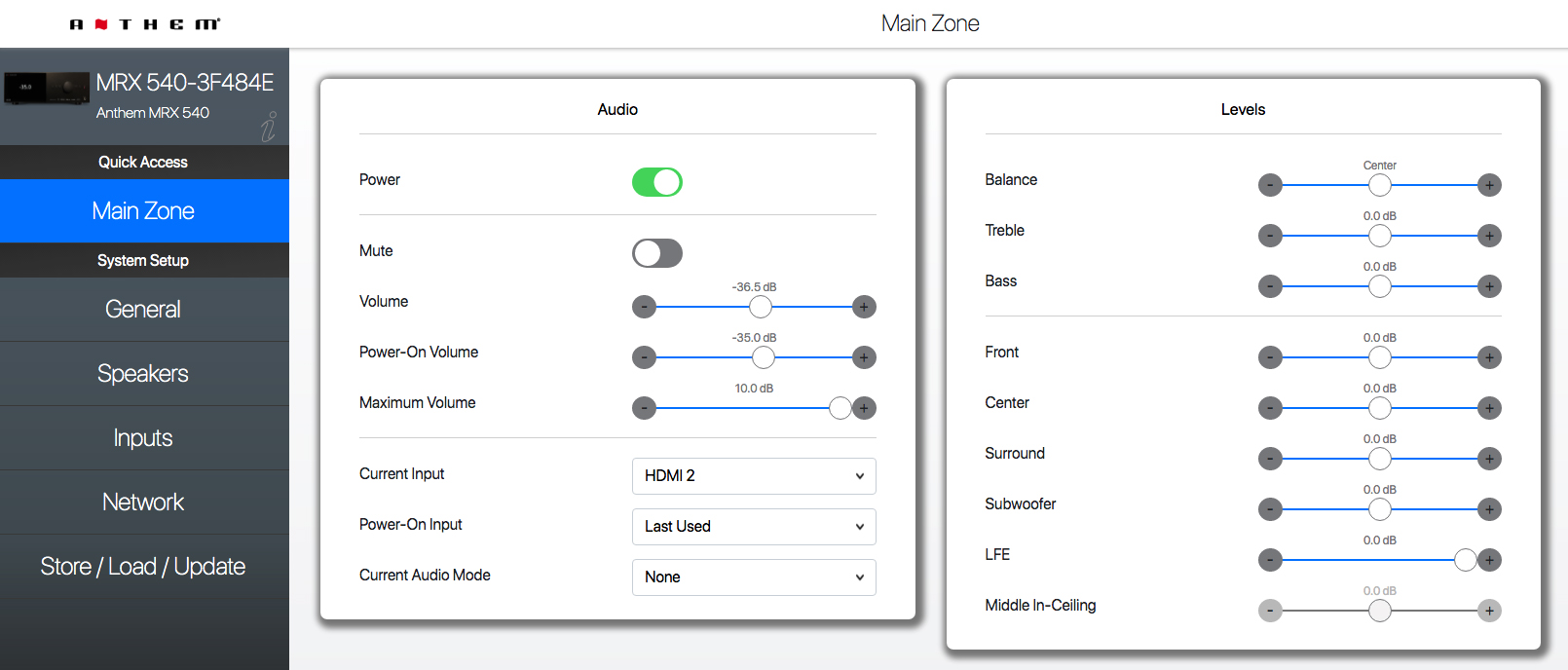Sound+Image Verdict
Anthem's revised design is a complete win in our books, no less so than its versatile functionality with its 7-channel pre-outs and 30 assignable inputs, and of course its stellar audio performance.
Pros
- +
Excellent Class-AB sound
- +
Web interface for settings
- +
Great input and pre-out options
- +
Stellar room correction
Cons
- -
No USB-B or phono inputs
- -
No built-in music services
- -
Some fan noise on our sample
Why you can trust What Hi-Fi?

This review originally appeared in Sound+Image magazine, one of What Hi-Fi?’s Australian sister publications. Click here for more information on Sound+Image, including digital editions and details on how you can subscribe.
The co-founder back in 1982 of Canadian brand Paradigm, Scott Bagby, took 100% ownership of Paradigm, Anthem and MartinLogan Loudspeakers in 2019, removing from the equation the private-equity involvement of America’s Shoreview Industries – although Bagby and his Paradigm co-founder Jerry VanderMarel had originally acquired the Anthem brand way back in 1998.
The operational freedom thus gained seems not to have been in the least restrained by the Covid disruptions of the last 18 months. In December last year Anthem announced an entirely new suite of AV products – nine new models of processors, power amps and integrated AV receivers, rebuilt and redesigned to update the full Anthem range for all the latest technologies.
This MRX 540 is the junior of the three new AV receivers, its siblings rising to the MRX 1140 with its 11 channels of amplification and processing for up to 15.2 channels. The MRX 540 reviewed here offers five channels of amplification, rated at 100W per channel with all channels driven, though again it can process more, up to seven channels.
Its power is proper Class-AB; this is not a company which has yet been seduced by the efficiencies of Class-D modules. And on that foundation Anthem presents something remarkable here, as this receiver is loaded with secret weaponry, and we found both the style and substance on offer from this receiver to be particularly impressive.
New look, new interface
So Paradigm, Anthem, and MartinLogan are all based in Mississauga, Ontario, where among other delights they have access to the research and facilities of the legendary National Research Council of Canada.
Here in Australia, Anthem doesn’t have quite the brand recognition of some competitors; in Connected magazine’s ‘Most Popular’ survey for 2020 the leaders in AV receivers ran from Yamaha, Denon and Integra to Marantz, Pioneer and Onkyo.
But across the Pacific, this position is reversed, with Anthem vying for the top spots in both brand recognition and market share. The MRX 540 demonstrates why – indeed, it’s hard to know quite where to start. But let’s begin with two relatively superficial aspects that impressed us initially – its physical design, and its network access to settings menus.
The latest hi-fi, home cinema and tech news, reviews, buying advice and deals, direct to your inbox.
Compare Anthem’s previous AV receivers with the new range and it’s like they’ve moved forward into a different century, from twin knobs either side of an LCD display in the middle (yawn), to this new stylishly-fonted modern graphic display dominating the entire left half of the fascia, with a single large knob to the right, flanked by a trio of small buttons on each side.
This new look has come straight from the recent STR amplifier series, and it’s an unmitigated success here. We gather it’s not only the outsides which have gained from the STR amplifiers; new circuit ideas have also been applied to the new receivers. All this development goes on at the Paradigm/Anthem Advanced Research Center in Gloucester, Ottawa. This receiver is actually built in Vietnam.
The new fascia layout and display make it easy to use the supplied remote control to shuttle through the options and settings available, but that is very much not the way you will want to interact with your Anthem receiver once you discover the Anthem Web User Interface.
As soon as the receiver is networked, you check its network menu to get its IP address (e.g. 192.168.1.14), then type that into any browser on your network – on your computer, your iPad, even your phone. Up pops a super-friendly and frankly addictive interface with which you can do all the key set-up for everything you’d otherwise be doing on your knees with the remote control.
Many other receivers, of course, offer similar access to settings through their on-screen menus; the Anthem also does this if you adjust settings using the remote control.
That’s handy, but it interrupts and overlays what’s showing on your big screen; we’ve seen some overlays that even cause resolution changes that kick off a sequence of fresh HDMI handshakes. By moving this to a web interface, you can have the Anthem playing away while you adjust stuff on your phone or tablet. Second-screening your settings in this way is a great advance.
Inputs and virtual inputs
The MRX 540 is pretty well-equipped with inputs for a receiver at this level. There are seven HDMI inputs and two HDMI outputs, one of them with eARC. There are five sets of analogue inputs on RCA sockets, three optical digital inputs, two coaxial digital inputs, plus three trigger sockets, an IR extender input and an RS-232 connection.
The outputs are also unusually prolific for this level, with five sets of speaker binding posts, but also a full set of RCA line-level pre-outs for all five channels plus two extra (because of the seven-channel processing), plus a pair of stereo line outputs and two undifferentiated subwoofer outputs. There’s even an optical output. And there’s a full-size headphone output on the front panel.
What’s not included? There’s no USB-B for direct computer playback, and there’s no phono stage. Nor is there much in the way of built-in streaming services, though there is AirPlay 2 and Chromecast and Bluetooth for point-to-point streaming (see below).
All inputs are easily selected and ready to go out of the box, but we can again almost guarantee that once you’ve cottoned on to Anthem’s system of virtual inputs, you won’t be using those any more.
For each designated input, you can reallocate everything (see screengrab below) – the choice of video socket, the audio socket, the speaker profile, the use of Anthem Room Correction, lip-sync delay and volume trim, whether to apply additional Dolby post-processing for Music, Movie or Night settings, or a ‘listening mode’ which can upscale mono or stereo signals to a wider set of speakers. And not only can you make changes to the standard inputs, you can create entirely new ones, up to 30 virtual inputs in total.
We quickly made stereo variants for 2.0 and 2.1 so we could listen to music with or without the subwoofer in circuit. Better still we could still tweak the subwoofer’s settings on the fly using our iPad while listening to music, hearing and tweaking the result.
And you can rename each of these virtual inputs, with the rewritten names immediately reflected on the front-panel display. Custom installers must love this, as it looks so professional (and intuitive) to have the inputs clearly named, instead of having to select HDMI 3 for Blu-ray, Optical 2 for your CD player, etc. We loved this; it looks so good.
Other brands do offer similar systems – Yamaha, for example, has its ‘Scenes’ increasingly to the fore on its receivers. But that’s nothing like as intuitive as the system here. You can also easily switch the front panel from showing dB settings for volume, which can confuse some users, to show instead a percentage volume scale from 0 to 100.
Under the web interface you can also define the four available Speaker Profiles. We were doing so when we noticed that the manual advises it’s much easier to do so using the Anthem Room Correction software.
We confess that normally we save room correction for the closing stages of our reviews. But given this advice, we moved things forward, and headed back to the Anthem packaging to retrieve the microphone system required to set ARC under way.
Anthem room correction
Anthem Room Correction is the end result of the Athena project developed by Canada’s National Research Council. Which gave us more hope than usual.
We’ve always doubted the microphones in room correction systems especially, clearly critical to success but rarely of any real quality – how much of a receiver’s budget would a company spend here given it’s a one-off setting which a good many users may never even employ? Anthem has invested in better microphones (pictured) for the latest range, in addition to software improvements.

You head to anthemarc.com to download the required software; the online manual indicated the MRX units require the beta version, but the website itself supersedes this advice, pointing you to the new ARC Genesis.
We used a MacBook Pro laptop to allow freedom of movement, since you attach the microphone to the computer, not the receiver. The software installed easily, even cleaning up nicely after itself, and we selected the ‘Auto Mode’, though there’s also a Pro Mode if you desire, supporting a “granular level of customisation”.
On the microphone, a dot with a sticker indicates this should face the front of the room. How do you get it into the perfect position? Anthem includes a large dual-pivoting microphone stand in the box!
Compare this to most such systems which come with a curious puck microphone and at best a piece of folding cardboard to support it (“use milk crates!” one instruction manual volunteers for this lack of provision). Here the microphone is light but high quality, a USB-C connector in its base.
You have to measure from at least five positions, these being where your head would normally be, then the front left and right of your couch, finally a little behind the left and right of your couch.
We selected to calibrate in 5.1, in 2.0 and in 2.1, so we had to move the microphone fourteen times (possibly the software might be designed to do all three calibrations from the first position, then the second, which would reduce this to four moves…).
Also the software says to point the microphone at the ceiling, which may confuse those who have pointed the dot to the front as requested. Also do you keep the dot facing forwards when in the side positions, or toed in a little to point at the centre of the screen? This we do not know.
However, we have never been so confident that the system was getting a high-quality input with which to perform its calibration process, whatever one’s view of room correction in general may be.
Process completed, you upload the results to the receiver, and you can save a PDF of the results, or view them on screen. For each calibration and each speaker this shows you the measured curve, the desired curve and the corrected curve. It announced that we had a room gain of nearly 4dB centred on 200Hz, which matches what we’ve previously established, and no deep bass boost that needed correction.
An unusual feature of Anthem’s ARC is that it recognises the value of room effect and doesn’t try to wipe it out entirely, thereby removing the warmth we’re all used to. Canadian brands are big on room effect – compare this to Paul Barton’s RoomFeel, also developed with the NRC.

And perhaps this is why, when we tried out the results, we liked them. We very very rarely do, or we can’t hear a difference at all, but here it was obvious, and positive. We listened first in stereo (we had calibrated for stereo also), and with Walk on the Wild Side the ARC added warmth to Lou Reed’s vocal, not reducing its cut-through in any way, but changing it from something just slightly clinical to something more real and round.
There was a similar reality boost for Leonard Cohen’s difficult wide-band vocal on the ‘Live on London’ version of Tower of Song, while Joni Mitchell’s latter version of Both Sides Now just came to life under the ARC’s amended curve; it hollowed out without it.
Only when we had this track’s climax up and pumping did the corrected version sound a little strained, slightly pushed compared with the uncorrected version, as if the boosted frequencies were over-boosted.
But this is not only the most successful room correction we’ve ever used for stereo, it’s the only one we’ve ever chosen to leave engaged. Besides, with the web interface up on the iPad, or the MacBook at this point, we could choose to flick it on or off as the particular case deserved.
Unlike some systems, the Anthem ARC does not set your speaker distances automatically; you need to do those in advance, or afterwards. Requiring only a tape measure to achieve, this should not prove a challenge even for technophobes.
Multichannel sound
With surround soundtracks, the ARC proved even more effective, improving tone, steering and in particular the bass management. We ran the Atmos-TrueHD opening of the first Hobbit movie from UHD Blu-ray, and with ARC the centre-channel narration by Bilbo was cured of a slight over-rounding, and the whole sound seemed clarified and more focused.
Without ARC the arrival of Smaug was huge and blustery; with ARC engaged it was huge and exciting, the realm between subwoofer and midrange notably cleared out so that individual effects were more easily discerned and the full soundstage simply better defined and more integrated.
This all adds to what had already been a solid surround performance, now raised to an alarmingly addictive level. We would run a test scene – the Nile opening of X-Men: Apocalypse, for example – and were kept spellbound by subsequent scenes, with some spectacular steering of Scott’s toilet banging scene, and the cage-fight. We’ve seen all this before, but it was repeatably entertaining when delivered with a marvellously impressive soundfield, and wodges of power.
That power is quoted at 100 watts per channel continuous power into eight ohms, or 130W into six ohms, though these figures are measured allowing 1% THD, far higher than for hi-fi equipment. All five channels on this receiver are identical, though on the higher Anthem receivers some channels have reduced power available.

Anthem comments that when driving all channels the power drop on each is less than 1dB, when it’s not unusual for all-channel power to drop by 30% or more compared with single-channel power. With everything we played through the Anthem, we had no sense of limitation; quite the opposite, indeed: the power was palpable.
We were running with sizeable speakers in a small to medium space, so larger rooms may benefit from the increased power of higher models; it seemed simply unrequired in our space.
The higher two Anthem receivers do, however, have the benefit of what the company calls ‘Amp Matrixing’, which adds the further versatility of allocating the amp channels to different purposes. In those models you could use an external amplifier for the L, R channels (via the preout sockets) and allocate the unused amplifiers for height or back surrounds.
The MRX 540 is less flexible. It offers preouts for all channels, including a bonus pair which can be allocated to height or back surround. But if you want to use those, for 7.1 or 5.1.2, you’ll need to bring your own amp; you can’t reallocate the other channels to them. Which is a pity, but you could still use preferred external amps for L/R and just leave the Anthem L/R ones unused.
We ended up trying that, so that we could restore our reference power amps to their rightful role when playing stereo. With all those preouts available for everything, there is still great flexibility.
The Anthem can decode both Atmos and DTS:X in addition to lesser surround formats. It also passes HDR including Dolby Vision from HDMI inputs to its output, and has eARC so it can play surround formats received by your TV down the HDMI cable connection. It is also compatible with IMAX Enhanced (the purpose and utility of which we’ve yet to grasp).
The current run of MRX 540s, including our unit, has HDMI 2.0b silicon, but will be hardware upgradeable to 8K-compatible HDMI 2.1, primarily for gamers seeking 4K/120 support for the latest consoles; the Australian distributor Audio Active tells us the switch to the replacement board will cost AU$99. Another running change during production may be to replace the 32-bit 768kHz DAC, which is from AKM, whose supplies are now restricted not by Covid but by a factory fire in Japan.
Streaming smarts
Of course receivers today generally contain a whole lot more than just amplifiers. They’re expected to stream music and often a whole lot more. The Anthems are rather less endowed in this way than Yamaha with its MusicCast platform, or Denon and Marantz with HEOS.
Rather than have a streaming and multiroom module onboard, the Anthem instead hosts Chromecast, AirPlay 2 and Bluetooth, which should cover music streaming from any device of choice, and is certainly a great step forward from the previously supported DTS PlayFi.
These are all point-to-point streaming, however, so that the Anthems don’t offer internet radio, let alone FM or DAB+ which some rivals have; there’s no DLNA/UPnP network streaming, and indeed the receiver cannot itself stream music direct from the internet in any way, except for Spotify Connect, which is listed as ‘coming soon’.
So is Roon compatibility, which will then enable direct Tidal and or Qobuz streaming under Roon control, though requiring ongoing subscriptions to both Roon and your service of choice. That option aside, there’s a fair argument here for getting a separate streamer and plugging it in. And why not.
More impressive, and another recommendation for custom installers, is the easy integration with multiple control systems – Control4, RTi, Savant, Elan, Crestron and URC all have drivers available. And while previous Anthems required laborious manual software updates from a USB stick, this can now be done over the internet.
We had networked the Anthem with an Ethernet cable; there is also Wi-Fi onboard, though this requires adding the longest antennas we can ever recall seeing, more than 19cm long, almost doubling the effective height of the MRX 540.
Anything we didn’t like? Well the remote control is not a highlight of the system, feeling a little cheap and spongy, with some weird choices – the second set of rockers might be better giving prominence to something other than ‘PG/PR (DTS:X Dialog Level Control)’; there’s a whole block of Zone 2 controls which don’t apply to this receiver, and having separate buttons for power off and power on might be handy for integrators organising remote commands, but left us invariably pressing the wrong one.

The binding posts for speaker connections are also disappointingly average – budget plastic posts, a little wobbly under the pressure of large speaker cables.
More seriously we experienced a distracting level of noise coming from the receiver on regular occasions; a chattery noise we first thought to be the machinations of a nearby NAS drive, but no, it was from a fan blowing hot air up from the back right of the Anthem.
This might be just our sample, or the result of us electing to leave the MRX 540 permanently on, which Anthem describes as “not recommended… it needs very little time, especially if actually playing something, to reach operating temperature and sound its best.”
Vinyl fans have no phono stage here, so will require an external phono stage, or a turntable with one built-in. We noted here a nice suggestion from Anthem in its online FAQs, that “an old receiver can be substituted for a phono preamp – connect the turntable to the receiver’s phono input, and connect the receiver’s tape output to the preamplifier input”.
This was how we connected our own turntable, using our resident Musical Fidelity preamp blessed with a fine phono stage. In our final listening sequence we did have our resident power amps running left and right channels, and when listening to the turntable in stereo, we had no inkling that the Anthem was digitally sampling the analogue inputs (at 24-bit/96kHz); it had no apparent destructive effect; our system had exactly the performance we usually enjoy, plus the Anthem’s surround sound when required.
It’s a happy thought for stereo purists who want surround sound for home entertainment without compromising their purist stereo performance in the process.
Those FAQs on Anthem’s website are a nice read; they’re so very lacking in marketing drivel. Here’s another: “Question: Are they better suited for music or for movies? Answer: Sound reproduction equipment doesn’t know the difference between a music signal and a movie signal, or for that matter the musical score within a movie soundtrack. Accurate for one means accurate for the other.”
Quite right. We sometimes say a unit works well with movies, less so with music. But what we really mean is that inaccuracies are self-evident with music, but more acceptable when masked by the complexities of a movie soundtrack. Inaccurate is just inaccurate, as Anthem rightly says.
Final verdict
So we ended up not only enjoying the entertainment flowing from Anthem’s MRX 540 very much indeed, but also simultaneously warming to the company which made it.
We love their thinking, their implementations, the new aesthetic, the versatility here – and underlying it all, the performance. It’s an unreserved recommendation from us.

Jez is the Editor of Sound+Image magazine, having inhabited that role since 2006, more or less a lustrum after departing his UK homeland to adopt an additional nationality under the more favourable climes and skies of Australia. Prior to his desertion he was Editor of the UK's Stuff magazine, and before that Editor of What Hi-Fi? magazine, and before that of the erstwhile Audiophile magazine and of Electronics Today International. He makes music as well as enjoying it, is alarmingly wedded to the notion that Led Zeppelin remains the highest point of rock'n'roll yet attained, though remains willing to assess modern pretenders. He lives in a modest shack on Sydney's Northern Beaches with his Canadian wife Deanna, a rescue greyhound called Jewels, and an assortment of changing wildlife under care. If you're seeking his articles by clicking this profile, you'll see far more of them by switching to the Australian version of WHF.



